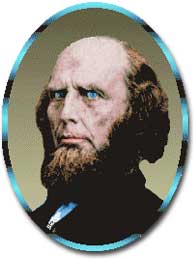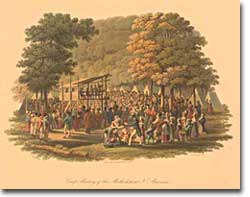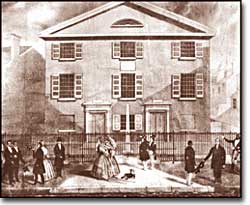26a. Religious Revival

Charles Grandison Finney was one of the most famous and most controversial travelling preachers during the Second Great Awakening. His work is still commended and criticized by a number of groups.
Standing on a hilltop in upstate New York, with the breeze blowing lightly through his hair, the Reverend Charles Grandison Finney surveys his audience. He is about to say something startling. In his grand baritone, he begins by exhorting them to listen carefully; he is about to change their lives. Salvation is the beginning of a life of good works here on earth! Man can, therefore, achieve his own salvation. God is not angry! God is merciful and loving. Therefore, go forth, and do as well as believe!
His flock was duly astounded. This was a unique and welcome message coming from the mouths of Reverend Finney and other American evangelists who began spreading the news of the Second Great Awakening from New England to the West from approximately 1795 to 1835. This was a message of hope and opportunity. Religion was not only revived it was being transformed. Gone were the warnings that man was totally depraved; that he was "predestined" to salvation or damnation; that God was angry and full of vengeance. The amazing assurance that life on earth had its own rewards and was not just a way station on the road to heaven (or hell) touched people's hearts. And they rushed to hear it.
Thus, the revolt against Jonathan Edwards' strict Calvinism produced many new sects. The area around central New York and along the Erie Canal was a fertile ground for Pentecostal fervor and conversion so intense it was referred to as the "Burned Over District." William Miller founded the Adventist sect based on the notion that he could pinpoint the exact day when the Messiah would return to earth.

Revival meetings like the one illustrated here were filled with exuberant outbursts of religious fervor.
After having a series of religious visions, Joseph Smith, a young man from Palmyra, New York published the Book of Mormon and established the Church of Jesus Christ of Latter Day Saints in 1830. The church was plagued with persecution from the very beginning because of its evangelizing, its separation from surrounding communities, and its radical ideas, including polygamy. Its members, commonly referred to as Mormons, were constantly on the move to avoid harassment. After Joseph Smith and his brother Hyrum were killed by an angry mob in Nauvoo, Illinois in 1844, the church members headed West under the leadership of Brigham Young. After a long, difficult trek, 140,000 Mormons settled in Salt Lake City, Utah.
Ultimately, many of these groups as well as established Protestant churches like Baptists, Methodists, and Congregationalists moved to the West, carrying their message of revival and redemption with them. Since danger and uncertainty abounded on the frontier, evangelists discovered that the promise of salvation could be delivered with even more zeal. James McCready made his name preaching "hellfire and brimstone." Peter Cartwright traveled across the frontier and brought religious services to countless remote Americans as one of the premier Methodist circuit riders. Sin and repentance dominated the camp meeting, a gathering that often lasted for days and attracted thousands of shrieking, sobbing, fainting converts. The message was simple: Repent your vices and God will forgive you!

With the exception of the Society of Friends (the Quakers), no church in the nation took a public stance against slavery. Northern churches, like the African Methodist Episcopal Church in Philadelphia, were segregated.
The movement was perfectly in tune with Jacksonian America. Methodists and Baptists made the greatest gains in numbers of members. With a less formal clergy and the notion that anyone could be saved, these groups meshed nicely with Jacksonian Democracy. Women became more involved than men, and preachers soon used the revival to promote "women's sphere." Soon reform movements designed to improve the worst evils of industrial emerged from the churches America.
At the same time the Second Awakening was freeing men and women in the north and west, churches in the south began adopting a more authoritarian, paternalistic tone and did not encourage thinking about or questioning of social institutions, since such probing might have an undesired effect. The idea that all men have a spark of divinity and are therefore to be treated equally and benevolently did not mesh well with the existence of slavery. But everywhere else in America, the church and the clergy became, at least in spirit, a champion for the common man, his individual dignity and salvation, and the betterment of his condition.






